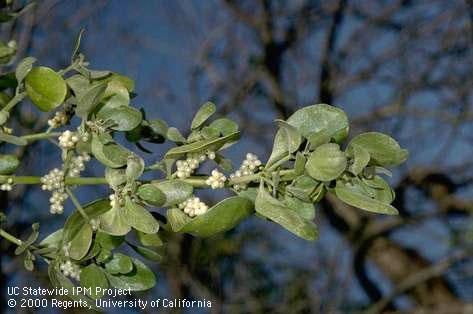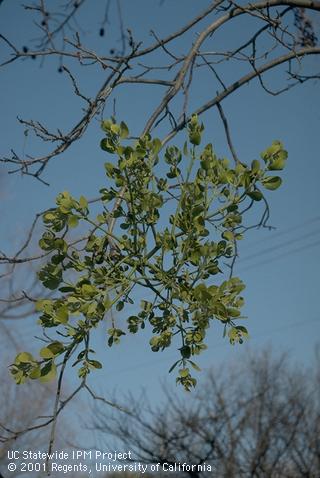
Part of Christmas tradition, this parasitic plant can be deadly to trees

|
|
Mistletoe's white berries are a favorite of birds, who help spread the parasitic
plant. (Photos courtesy UCANR)
|
A tree full of mistletoe may seem like a romantic idea – you could kiss anytime under its branches, not just at Christmas.
But mistletoe could be the kiss of death for its host. This evergreen parasite can slowly kill a tree, sucking out its nutrients and moisture. It’s particularly troublesome for trees stressed by drought or disease.
Over a few Christmases, I watched a beautiful crop of mistletoe slowly take over a neighbor’s birch, one branch at a time, until the tree finally died altogether.
Most of the mistletoe we see in Sacramento is broadleaf mistletoe, Birds – especially cedar waxwings and robins – enjoy the plant’s sticky white berries. It’s the birds that usually spread those berries and resulting mistletoe around.
According to UC Cooperative Extension master gardeners, broadleaf mistletoe (Phoradendron macrophyllum) can infest several different kinds of landscape trees including alder, ash, birch, box elder, cottonwood, locust, silver maple, walnut and zelkova plus some varieties of flowering pear. Modesto ash in particular is very susceptible.
Another species of mistletoe attacks only oak trees. In the Sierra foothills, dwarf mistletoe infests pines, firs and other conifers.
“Broadleaf mistletoe absorbs both water and mineral nutrients from its host trees,” say the master gardeners. “Healthy trees can tolerate a few mistletoe branch infections, but individual branches may be weakened or sometimes killed. Heavily infested trees may be reduced in vigor, stunted, or even killed, especially if they are stressed by other problems such as drought or disease.”
New, young trees, which can be stunted by mistletoe, are at risk from infestations of nearby older trees.
The most effective control? Pruning. Cut out infected branches, particularly while the mistletoe plants are small. If a tree is badly infested, remove the whole tree, say the master gardeners.

|
|
Mistletoe grown this big means the tree host is at risk of dying.
Prune it out to get rid of it. |
How did a parasitic plant come to inspire Christmas kisses? The tradition can be traced back to ancient Greece.
Historians say mistletoe was a symbol of fertility. Ancient Greeks incorporated mistletoe as part of Saturnalia, a late December celebration of the god Saturn. Couples kissed under mistletoe for luck, a tradition that was also used during marriage ceremonies.
The Romans regarded mistletoe as a symbol of peace, say the historians. Warring factions kissed and made up under a sprig of mistletoe.
In the British Isles, the Druids and ancient Celtics thought mistletoe contained magical powers and used it in ceremonies. That connection got mistletoe banned in many Christian places of worship.
Mistletoe also has a role in Norse legends and other mythology; this little plant got around. Often the legends ended with a kiss under the mistletoe.
Across continents and centuries, the kissing part endured, making mistletoe memorable – more for what it inspires than what it actually does.
For more about mistletoe, check out the UC Cooperative Extension pest notes: http://ipm.ucanr.edu/PMG/PESTNOTES/pn7437.html .
Comments
0 comments have been posted.Sacramento Digs Gardening to your inbox.
Food in My Back Yard Series
April 22: Should you stock up on fertilizer? (Yes!)
April 15: Grow culinary herbs in containers
April 8: When to plant summer vegetables
April 1: Don't be fooled by these garden myths
March 25: Fertilizer tips: How to 'feed' your vegetables for healthy growth
March 18: Time to give vegetable seedlings some more space
March 11: Ways to win the fight against weeds
March 4: Potatoes from the garden
Feb. 25: Plant a fruit tree now -- for later
Feb. 18: How to squeeze more food into less space
Feb. 11: When to plant? Consider staggering your transplants
Feb. 4: Starting in seed starting
Sites We Like
Garden Checklist for week of April 27
Once the clouds clear, get to work. Spring growth is in high gear.
* Set out tomato, pepper and eggplant transplants.
* From seed, plant beans, beets, cantaloupes, carrots, corn, cucumbers, melons, pumpkins, radishes and squash. Plant onion sets.
* In the flower garden, plant seeds for asters, cosmos, celosia, marigolds, salvia, sunflowers and zinnias. Transplant petunias, zinnias, geraniums and other summer bloomers.
* Plant perennials and dahlia tubers for summer bloom. Late April is about the last chance to plant summer bulbs, such as gladiolus and tuberous begonias.
* Transplant lettuce and cabbage seedlings.
* Weed, weed, weed! Don’t let unwanted plants go to seed.
* April is the last chance to plant citrus trees such as dwarf orange, lemon and kumquat. These trees also look good in landscaping and provide fresh fruit in winter.
* Feed citrus trees with a low dose of balanced fertilizer (such as 10-10-10) during bloom to help set fruit. Keep an eye out for ants.
* Apply slow-release fertilizer to the lawn.
* Thoroughly clean debris from the bottom of outdoor ponds or fountains.
* Start thinning fruit that's formed on apple and stone fruit trees -- you'll get larger fruit at harvest (and avoid limb breakage) if some is thinned now. The UC recommendation is to thin fruit when it is about 3/4 of an inch in diameter. Peaches and nectarines should be thinned to about 6 inches apart; smaller fruit such as plums and pluots can be about 4 inches apart. Apricots can be left at 3 inches apart. Apples and pears should be thinned to one fruit per cluster of flowers, 6 to 8 inches apart.
* Azaleas and camellias looking a little yellow? If leaves are turning yellow between the veins, give them a boost with chelated iron.
* Trim dead flowers but not leaves from spring-flowering bulbs such as daffodils and tulips. Those leaves gather energy to create next year's flowers. Also, give the bulbs a fertilizer boost after bloom.
* Pinch chrysanthemums back to 12 inches for fall flowers. Cut old stems to the ground.
* Mulch around plants to conserve moisture and control weeds.